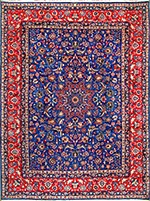Textiles Studies

Textile Research Works
Date of this Version
1992
Document Type
Article
Citation
THE TEXTILE MUSEUM JOURNAL 1992, pp. 53-70
Abstract
Historically, in the Islamic world from Spain to Indonesia, two-dimensional repeat patterns have served as primary means for organizing color and space. The ornamentation of architecture may involve the modifications of a two-dimensional pattern in its application to a three-dimensional surface. All of the uses of pattern, appearing as well on ceramics and metalwork, in book illumination, and textiles, rely upon the repetition of complex or simple designs to form overall repeat patterns of apparent complexity and intricacy. Yet within all the visual diversity and within the variability of regional traditions throughout the Islamic world, there is a common visual language expressed through pattern. Exemplifying beautifully the play of pattern, Oriental carpets fall within the realm of Islamic art. They offer a rich corpus of two-dimensional design, and an opportunity to study mathematical aspects of pattern. Patterns begin with symmetry. Patterns are created by the regular repetition of form according to the principles of symmetry. Patterns may pfease the eye and engage the mind-or they may be insistent, boring, distracting. They may harness our thought, or imprison our creativity. W hile the mathematical definition of a pattern may be absolute and precise, symmetry in nature is only ever approximate. Outwardly, man appears to be bilaterally symmetrical, yet no two sides of a person are exactly alike. It seems to be this appearance of symmetry in art as in nature-an approximation-that is most pleasing to the eye. Patterns with imperfections continually fascinate us because they confound and perplex us as they delight. It is important to distinguish the difference between a design and the way its elements are repeated at regular intervals to form a pattern. By focusing on the difference between the analysis of design and the analysis of pattern in Oriental carpets, one may approach a better understanding of infinitely repeating patterns in Islamic art.
Included in
Art and Materials Conservation Commons, Art Practice Commons, Fiber, Textile, and Weaving Arts Commons, Indigenous Studies Commons, Museum Studies Commons


Comments
Copyright of Textile Museum Journal is the property of Textile Museum and its content may not be copied or emailed to multiple sites or posted to a listserv without the copyright holder's express written permission. However. users may print. download. or email articles for individual use. This posting on academia.com and bepress.com has been approved by The Textile Museum, 9/5/23.